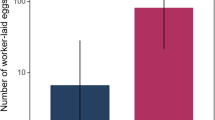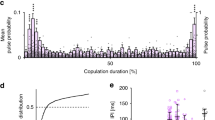Abstract
We first reported menstrual synchrony almost three decades ago, and it has since been verified repeatedly. But synchrony does not always occur, and the circumstances in which it does not occur tell us a great deal about the social and physical conditions required1,2. Menstrual synchrony is but one manifestation of a more fundamental mechanism, the chemosensory regulation of ovulation, which occurs in other species not only as synchrony, but also as asynchrony, extreme cycle regularity, changes in the timing of puberty, birth cycles and reproductive ageing1,2.
This is a preview of subscription content, access via your institution
Access options
Subscribe to this journal
Receive 51 print issues and online access
$199.00 per year
only $3.90 per issue
Buy this article
- Purchase on Springer Link
- Instant access to full article PDF
Prices may be subject to local taxes which are calculated during checkout
Similar content being viewed by others
References
McClintock, M. K. in Reproduction in Context (eds Wallen, K. & Schneider, J.) (MIT Press, Cambridge, Massachusetts, 1999).
McClintock, M. K. Annu. Rev. Sex. Res. 9, 77–95 (1999).
Trevathan, W. R., Burleson, M. H. & Gregory, W. L. Psychoneuroendocrinology 18, 425–435 (1993).
Stern, K. & McClintock, M. K. Nature 392, 177–179 (1998).
McClintock, M. K. in Chemical Signals in Vertebrates (eds Müller-Schwarze, D. & Silverstein, R. M.) 159–178 (Plenum, New York, 1982).
Stern, K. & McClintock, M. K. in Psychopharmacology of Women (eds Jensvold, M. F., Halbreich, U. & Hamilton, J.) 393–413 (American Psychiatry Press, Washington DC, 1996).
Schank, J. & McClintock, M. K. J. Theor. Biol. 157, 317–362 (1992).
Author information
Authors and Affiliations
Corresponding author
Rights and permissions
About this article
Cite this article
McClintock, M. reply: Pheromones and regulation of ovulation. Nature 401, 232–233 (1999). https://doi.org/10.1038/45722
Issue Date:
DOI: https://doi.org/10.1038/45722
Comments
By submitting a comment you agree to abide by our Terms and Community Guidelines. If you find something abusive or that does not comply with our terms or guidelines please flag it as inappropriate.



